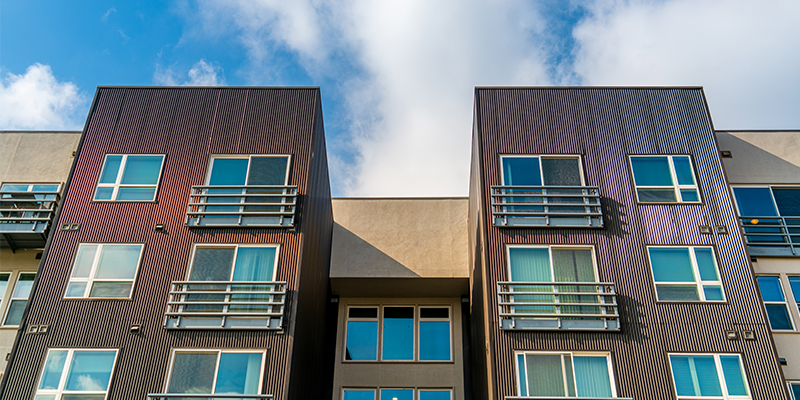In June, NAIOP conducted its eighth survey of its U.S. members on the impacts of COVID-19. Since April 2020, the association has examined the pandemic’s effects on commercial real estate and how firms have responded. Most American adults are vaccinated, and daily coronavirus case counts have plummeted in the five months since the previous survey. This has allowed a widespread return of customers to restaurants and retailers, and most observers now expect that office occupancy rates will rebound in the fall when schools re-open for in-person instruction.
Respondents to the survey report a strong recovery in retail property rent collections, as well as retail property acquisitions and development activity, alongside continued favorable trends for industrial, office and multifamily properties. Less than one-quarter of respondents now expect the pandemic to significantly affect their business operations for more than a year, and respondents are much more optimistic about employment within their own firms than in previous surveys.
Although business conditions have improved for commercial real estate, 86.6% of developers now report delays or shortages in construction supplies—an all-time high since the survey began in April 2020. This suggests that supply chain disruptions may outlast other effects of the pandemic, increasing construction costs and slowing new development.
Looking back at changes over the past year, the percentage of respondents reporting some type of deal activity has more than doubled for office and retail properties. It is also up substantially for industrial (92.2% vs. 71.2% in June 2020) and multifamily (76% vs. 58.6%) properties. The share of respondents reporting a decline in leasing for current development projects has dropped by more than half, but shortages of construction supplies and workers are both more acute now than a year ago. Although local governments have had more than a year to adapt to the pandemic, the share of respondents reporting delays in permitting or entitlements due to COVID-19 has remained unchanged since June 2020, with two-thirds of respondents reporting these delays.
The survey was completed by 239 NAIOP members between June 16 and 21, 2021. Respondents represent a range of professions, including developers, building owners, building managers, brokers, lenders and investors.
Below is an overview of the survey results with direct quotes from participants (in italics), followed by raw data from the survey and a profile of respondent characteristics. Results from January’s survey can be found here. Note that charts in this analysis illustrate data from the three most recent surveys. Data from previous surveys are published in earlier posts.
Building Acquisitions Now Common Across Property Types
Previous surveys have shown improving or stable acquisition and development activity for industrial, office and multifamily properties, with retail the last property type to register a recovery in deal activity. For the first time since NAIOP began the coronavirus impacts survey, most respondents reported witnessing some type of retail acquisition or development activity. Nearly a third (31.3%) reported new retail development, and 39.1% reported acquisitions of existing retail buildings, marking a sharp increase in both measures since the January survey. The other three property types have also experienced smaller increases in deal activity, with a slightly higher share of respondents reporting new industrial and multifamily development activity and office building acquisitions. Industrial properties continue to attract the most development activity, followed by multifamily, retail and office properties. Although retail properties are now attracting more reported development activity than office properties, the sector still significantly trails the other three property types in building acquisitions.
What types of commercial real estate acquisitions or new development have you witnessed occurring in the last three weeks in the markets in which you are active?




“Industrial is busier than I’ve ever seen it in my 30-year history in the business. Multifamily is also very busy. The issue going forward will be lack of product to sell or lease.”
“We are taking a wait-and-see approach to office [properties]. There is considerable uncertainty in how quickly and in what numbers employers come back to the office and what that means for space demand going forward.”
Rent Collections Returning to Normal
Respondents have consistently reported lower on-time rent collection rates for retail properties than other property types, but June’s survey revealed a substantial improvement in retail collections. Seventy percent of respondents reported that 90% or more of their retail tenants had paid their rent in full and on time by June 15, the first time most respondents have reported this rate of on-time collection for retail properties since the survey began in April 2020. Previous surveys had observed a return to high rates of on-time rent collection for industrial, office and multifamily properties, and those trends continued in June. With an increase in vaccination rates and loosening of COVID-19 restrictions, retail properties now appear to be participating more fully in the economic recovery that has benefited other property types.
What percentage of tenants in your properties have paid their rent in full and on time?*

*The survey asked what percentage of tenants had not paid their rent in full and on time by the 15th of each month. These charts display the difference between this percentage and 100%.
Alongside improved retail rent collections, fewer respondents reported requests for rent relief from retail tenants. The share of respondents reporting these requests fell to 37.7%, less than half the share that reported retail rent relief requests in January. Respondents also reported a decline in relief requests from industrial and multifamily tenants. The share of office tenants requesting rent relief in June remained higher than for industrial or multifamily tenants at 18%. As rent collections have improved, fewer respondents report offering rent relief options. A slight majority (52.7%) continue to offer rent deferrals that can be amortized over the remainder of a lease, down from roughly two-thirds of respondents in January. The share of respondents offering rent relief in exchange for a longer lease term has also declined, from 52.9% in January to 41.1% in June.

“Currently our retail centers are operating well and are 100% leased, even [those that requested] rent relief last year. None of the tenants closed due to COVID-19. The office tenants are slower to return, but all continue to pay rent and are starting to come back.”
A Mixed Picture for Development Projects, But Fewer Impacts on Building Operations
Developers report that several of the pandemic’s effects on ongoing projects have diminished significantly since January. The share reporting a decline in leasing fell to 22.7%, less than half January’s figure. Loosening of COVID-19 restrictions also resulted in a decline in the share of respondents reporting delays due to on-site social distancing, and delays in obtaining bridge loans are now rare, reported by only 4.1% of respondents.
However, the economy’s rapid recovery has also brought supply chain disruptions and exacerbated a longstanding construction workforce shortage. The share of respondents reporting supply shortages more than doubled to 86.6%, and the share reporting worker shortages increased to 40.2%, both record highs since the onset of the pandemic. Two-thirds of respondents also continue to report an increase in delays to obtain permits or entitlements due to COVID-19. That reading has remained persistently high and matches the share of respondents who reported this problem in June 2020. These trends suggest that although the pandemic’s effects on demand for commercial real estate have lessened substantially in recent months, impacts affecting the supply of new buildings appear likely to continue.
How has the coronavirus outbreak affected your current development projects?

As the share of the vaccinated population grows and the number of new coronavirus cases declines, fewer building owners and managers say they are following the more restrictive safety measures that many implemented earlier in the pandemic. Only 28.1% of respondents report closing common amenity areas, down from 55.6% in January. While only a minority had reported banning non-tenant visitors or closing properties due to state or local mandates in January, the share reporting both measures declined further in June (to 4.2% and 11.5%, respectively). Large majorities of owners and building managers continue to report more frequent cleanings (reported by 71.9% of respondents) and that they communicate additional hygiene and safety guidelines to tenants (reported by 60.4%).
“We are experiencing increased [costs] for supplies and delays for those supplies.”
Improved Outlook on Business Operations and Employment
The survey revealed increased optimism that the pandemic’s effects on commercial real estate will begin to recede in the near future. When asked how long they expect the pandemic to significantly impact their business operations, only 23% of respondents indicated that they expect the effects to last longer than a year, down from 39.6% in January. Just under half (45.6%) of respondents now expect the effects to last less than six months. Respondent comments suggest that some of those who see the pandemic’s effects lasting longer are concerned about long-term impacts on demand for office space or believe that it may take more than a year to fully resolve supply chain disruptions that affect the price of construction materials.

An increase in optimism within the commercial real estate industry is also reflected in respondent expectations for employment within their own firms. The share of respondents who expect their firms to add new hires increased from one-third in January to just under one-half in June. By contrast, no respondents reported that they expect their firms to reduce staff or compensation, and only a single respondent indicated that they expect reductions in staff hours. Few respondents now report that their firms will ask employees to telework.
What adjustments to staffing does your firm anticipate making over the next three months?

“[Our] properties [are] fully occupied now, but [we are] seeing tenants intending to exercise early terminations for leases in some cases. No subleasing by tenants currently, but [I] expect occupancy and rents for office/flex to decline over the next few years as leases mature and tenants reduce their office needs.”
“I’m in a tertiary urban market and our focus is 80% office, followed by industrial and retail […] Our income was fairly flat in 2020, but our expenses went up (due to our growth and additional costs of dealing with the pandemic). I anticipate additional pain for the next 18-24 months but gradually diminishing effects over that timeframe.”
“Hiring administrative staff and marketing professionals is a huge issue for us. We don’t have a pool of applicants, forget the qualifications.”
Survey Results
How long do you expect the events associated with the coronavirus pandemic to significantly impact your business operations?

How is the coronavirus pandemic currently affecting your development projects (select all that apply)?

What steps are you taking to improve the safety of your properties (select all that apply)?

What percentage of tenants in your properties have not paid their rent in full and on time as of June 15?

What percentage of tenants in your properties have approached you regarding rent reduction or relief as of June 15?

What steps is your firm taking when working with tenants to adapt to the pandemic (select all that apply)?

What types of commercial real estate acquisitions or new development have you witnessed occurring in the last three weeks in the markets in which you are active (select all that apply)?

What adjustments to staffing does your firm anticipate making over the next three months (select all that apply)?

Respondent Profile
Which of the following best describes your primary profession?

Which of the following property types do you currently own or operate? For mixed-use properties, please select all uses that apply.









